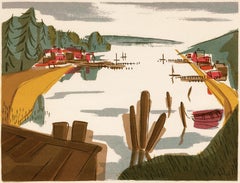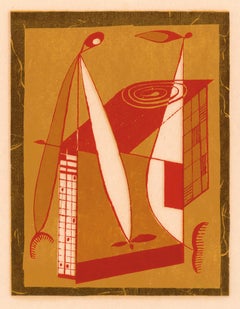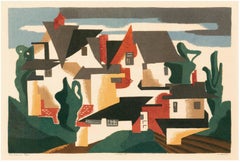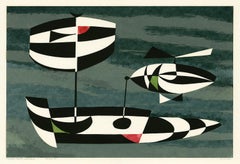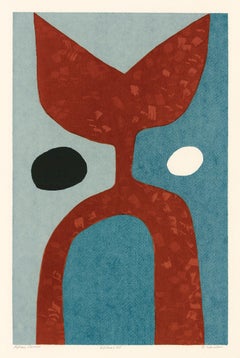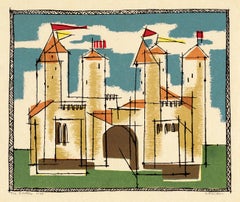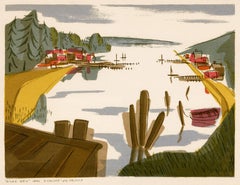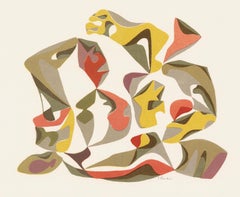Edward August Landon Prints and Multiples
to
2
16
Overall Width
to
Overall Height
to
9
4
3
16
1,208
958
924
835
16
2
1
8
8
2
2
2
1
1
1
1
1
16
16
Artist: Edward August Landon
'River View' — Mid-Century American Modernism
By Edward August Landon
Located in Myrtle Beach, SC
Edward Landon 'River View, color serigraph, 1942, edition 50, Ryan 159. Signed in pencil in the image, lower right. Titled, dated, and annotated '9 COLORS – 50 PRINTS' in the screen,...
Category
1940s American Modern Edward August Landon Prints and Multiples
Materials
Screen
'Chinoiserie' — Mid-Century Modernism
By Edward August Landon
Located in Myrtle Beach, SC
Edward Landon 'Chinoiserie', color serigraph, 1947, edition 50, Ryan 36. Signed in pencil in the image, lower right. Titled, dated, and annotated '4 COLORS – EDITION 50' in the scree...
Category
Mid-20th Century American Modern Edward August Landon Prints and Multiples
Materials
Screen
'The French Farm' — Mid-Century Modernism
By Edward August Landon
Located in Myrtle Beach, SC
Edward Landon, 'The French Farm', color serigraph, 1942, Ryan 86. Signed, titled, and annotated 'Edition 50' in pencil. A superb impression, with fresh colors, on cream, wove paper; ...
Category
Mid-20th Century American Modern Edward August Landon Prints and Multiples
Materials
Screen
'Flyable Objects Identified' — Mid-Century Modernism
By Edward August Landon
Located in Myrtle Beach, SC
Edward Landon, 'Flyable Objects Identified', color serigraph, 1969, edition 30, Ryan 83. Signed, titled, and annotated 'Edition 30' in pencil. A fine impression, with fresh colors, o...
Category
Mid-20th Century American Modern Edward August Landon Prints and Multiples
Materials
Screen
'Astral Comic' — Modernist Abstraction
By Edward August Landon
Located in Myrtle Beach, SC
Edward Landon 'Astral Comic', color serigraph, 1978, edition 25, Ryan 12. Signed, titled, and annotated 'Edition 25' in pencil. A superb, painterly impression, with fresh colors, on ...
Category
1970s Abstract Edward August Landon Prints and Multiples
Materials
Screen
'The Castle' — Mid-Century Modernist Children's Fantasy
By Edward August Landon
Located in Myrtle Beach, SC
Edward Landon 'The Castle', color serigraph, 1953, edition 35, Ryan 33. Signed, titled, and numbered '11/35' in pencil. A fine impression, with fresh colors, on cream Japan paper. Th...
Category
Mid-20th Century American Modern Edward August Landon Prints and Multiples
Materials
Screen
'Exhortation' (Priest) — Mid-Century Modernism
By Edward August Landon
Located in Myrtle Beach, SC
Edward Landon 'Exhortation (Priest)', color serigraph, 1957, edition 28, Ryan 72. Signed, titled, and numbered '21/28' in pencil. A superb, richly-inked impression, with strong color...
Category
Mid-20th Century American Modern Edward August Landon Prints and Multiples
Materials
Screen
'Nocturnal Adversary' — Mid-Century Surrealist Abstraction
By Edward August Landon
Located in Myrtle Beach, SC
Edward Landon 'Nocturnal Adversary', color serigraph, 1946, edition 50, Ryan 137. Signed in pencil in the image, lower right. Titled, dated, and annotated '6 COLORS EDITION 50' in th...
Category
1940s Surrealist Edward August Landon Prints and Multiples
Materials
Screen
'Counterpoint' — Mid-Century Modernist Abstraction
By Edward August Landon
Located in Myrtle Beach, SC
Edward Landon, 'Counterpoint', color serigraph, 1942, edition 25, Ryan 45. Signed, titled, and annotated 'Edition 25' in pencil. A fine impression, with fresh colors, on cream, wove paper; the full sheet with margins (7/8 to 2 1/2 inches). A 1 1/2 inch crease across the top left sheet corner, well away from the image, otherwise in excellent condition. Scarce.
Image size 13 9/16 x 14 5/16 inches (344 x 364 mm); sheet size 14 15/16 x 17 inches (379 x 432 mm). Matted to museum standards, unframed.
Literature:
'A Spectrum of Innovation: Color in American Printmaking', David Acton, New York, London, 1990.
'American Screenprints', Reba and Dave Williams, New York, 1987.
'The American Scene: Prints from Hopper to Pollock', Stephen Coppel, The British Museum, 2008.
Impressions of this work are held in the following museum collections: Albright-Knox Art Gallery, National Gallery of Art, Smithsonian American Art Museum.
ABOUT THE ARTIST
Born in Hartford, Connecticut, Edward Landon dropped out of high school to study art at the Hartford Art School. In 1930 and 1931 he was a student of Jean Charlot at the Art Students League in New York, after which he traveled to Mexico to study privately for a year with Carlos Merida. In 1933 he settled near Springfield, Massachusetts, painted murals in the local trade school, and exhibited with the Springfield Art League. His painting 'Memorial Day' won first prize at the fifteenth annual exhibition of the League at the Springfield Museum of Fine Arts. Landon became an active member of the Artists Union of Western Massachusetts, serving as president from 1934-1938.
Landon acquired Anthony Velonis’s instructional pamphlet on the technique of serigraphy in the late 1930s. With colleagues Phillip Hicken, Donald Reichert, and Pauline Stiriss, he began experimenting with screen printing techniques. The artists' groundbreaking work in screen printing as a fine art medium was the subject of the group’s landmark exhibition at the Springfield Museum of Fine Arts in 1940.
Landon became one of the founding members of the National Serigraph Society and served as editor of its publication, 'Serigraph Quarterly,' in the late 1940s and as its president in 1952 and 1953. The Norlyst Gallery in Manhattan held a one-person show of his prints in 1945. Awarded a Fulbright Fellowship in 1950, Landon traveled to Norway, where he researched the history of local artistic traditions and produced the book 'Scandinavian Design: Picture and Rune Stones...
Category
Mid-20th Century American Modern Edward August Landon Prints and Multiples
Materials
Screen
'Salient in February' — Mid 20th-Century Surrealism
By Edward August Landon
Located in Myrtle Beach, SC
Edward Landon 'Salient in February', color serigraph, 1945, edition 40, Ryan 166. Signed in pencil. Titled, dated, and annotated 'ED. 40' in pencil. A fine impression, with fresh col...
Category
Mid-20th Century Surrealist Edward August Landon Prints and Multiples
Materials
Screen
'Arrangement with Blue Major' — Musically Inspired Modernist Abstraction
By Edward August Landon
Located in Myrtle Beach, SC
Edward Landon, 'Arrangement with Blue Major', color serigraph, edition 40, 1942, Ryan 9. Signed, titled, and annotated 'Edition 40' in pencil. A superb impression, with fresh colors, on cream, wove paper; the full sheet with margins (3/4 to 1 5/8 inches), in excellent condition. Image size 15 x 9 3/4 inches (381 x 248 mm); sheet size 17 15/16 x 11 3/4 inches (456 x 298 mm). Matted to museum standards, unframed.
'Arrangement with Blue Major' was selected for the landmark ‘Artists for Victory’ exhibition at the Metropolitan Museum of Art in 1942. Impressions of this work are also in the collections of the Asheville Art Museum, Five Colleges and Historic Deerfield Museum Consortium, Georgetown University (Special Collections), Mount Holyoke College Art Museum, Rutgers University, Smith College Museum of Art, and the Springfield Museum of Fine Arts.
ABOUT THE ARTIST
Born in Hartford, Connecticut, Edward Landon dropped out of high school to study art at the Hartford Art School. In 1930 and 1931, he was a student of Jean Charlot at the Art Students League in New York, after which he traveled to Mexico to study privately for a year with Carlos Merida. In 1933 he settled near Springfield, Massachusetts, painted murals in the local trade school, and exhibited with the Springfield Art League. His painting 'Memorial Day' won first prize at the fifteenth annual exhibition of the League at the Springfield Museum of Fine Arts. Landon became an active member of the Artists Union of Western Massachusetts, serving as president from 1934-1938.
Landon acquired Anthony Velonis’s instructional pamphlet on the technique of serigraphy in the late 1930s. With colleagues Phillip Hicken, Donald Reichert, and Pauline Stiriss, he began experimenting with screen printing techniques. The artists' groundbreaking work in screen printing as a fine art medium was the subject of the group’s landmark exhibition at the Springfield Museum of Fine Arts in 1940.
Landon became one of the founding members of the National Serigraph Society and served as editor of its publication, 'Serigraph Quarterly,' in the late 1940s and as its president in 1952 and 1953. The Norlyst Gallery in Manhattan held a one-person show of his prints in 1945. Awarded a Fulbright Fellowship in 1950, Landon traveled to Norway, where he researched the history of local artistic traditions and produced the book 'Scandinavian Design: Picture and Rune Stones...
Category
Mid-20th Century Abstract Edward August Landon Prints and Multiples
Materials
Screen
'Forms in White' – Mid-Century Abstraction
By Edward August Landon
Located in Myrtle Beach, SC
Edward Landon, 'Forms in White', color serigraph, 1950, edition 30, Ryan 85. Signed in pencil. Dated, titled, annotated 'ED. 30' and '5 COLORS' in the screen, bottom center sheet edg...
Category
Mid-20th Century Abstract Edward August Landon Prints and Multiples
Materials
Screen
'Time Silhouette' —Mid-Century Modernism
By Edward August Landon
Located in Myrtle Beach, SC
Edward Landon, 'Time Silhouette', color serigraph, 1969, edition 30, Ryan 201. Signed, titled, and annotated 'Edition 30' in pencil. A fine impression, with fresh colors, on cream wo...
Category
Mid-20th Century American Modern Edward August Landon Prints and Multiples
Materials
Screen
'Evening' —Mid-Century American Surrealism
By Edward August Landon
Located in Myrtle Beach, SC
Edward Landon, 'Evening', color serigraph, 1958, edition 25, Ryan 71. Signed, titled, and annotated 'Ed. 25' in pencil. A fine impression, with fresh colors, on cream wove paper; the...
Category
Mid-20th Century Surrealist Edward August Landon Prints and Multiples
Materials
Screen
$680 Sale Price
20% Off
'Dark Vessel' — Mid-Century Modern
By Edward August Landon
Located in Myrtle Beach, SC
Edward Landon, 'Dark Vessel', color serigraph, 1952, edition 50, Ryan 51. Signed, dated, and titled in pencil. A superb impression, with fresh colors, on c...
Category
Mid-20th Century American Modern Edward August Landon Prints and Multiples
Materials
Screen
$600 Sale Price
20% Off
'Untitled Fantasy' — 1980s Surrealist Abstraction
By Edward August Landon
Located in Myrtle Beach, SC
Edward Landon, 'Untitled Fantasy', color serigraph, 1983, edition 30, Ryan 214. Signed, titled, and annotated 'Edition 30' in pencil. A fine impression, with fresh colors, on off-whi...
Category
Mid-20th Century Abstract Edward August Landon Prints and Multiples
Materials
Screen
Related Items
Homage to Barnett Newman /// Gene Davis Abstract Geometric Minimal Screenprint
By Gene Davis
Located in Saint Augustine, FL
Artist: Gene Davis (American, 1920-1985)
Title: "Homage to Barnett Newman"
*Signed and dated by Davis in pencil lower right
Year: 1979
Medium: Original Screenprint on unbranded soft-...
Category
1970s Abstract Edward August Landon Prints and Multiples
Materials
Screen
$2,500
H 36.63 in W 29.88 in
Headstand (San Francisco Museum of Modern Art) - Exhibition Poster
By Keith Haring
Located in Paris, IDF
Keith Haring
Headstand
Original vintage exhibition Poster printed in Screenprint
On thick paper
90 x 60 cm (c. 36 x 24 in)
INFORMATION: Official screenprint poster for the Haring e...
Category
1980s American Modern Edward August Landon Prints and Multiples
Materials
Screen
Ratfinkbonerthunk : Surrealist Rat - Original Giclee Print, Handsigned
By Kenny Scharf
Located in Paris, IDF
Kenny Scharf
Ratfinkbonerthunk : Surrealist Rat, 1990
Original Giclee Print
Handsigned in pencil
On Arches vellum 56 x 76 cm (c. 22 x 30 in)
Published by Editions Vermorel in 1990
...
Category
1990s American Modern Edward August Landon Prints and Multiples
Materials
Giclée, Screen
$1,795
H 22.05 in W 29.93 in
He Repeated the Letters of the Alphabet
By Corita Kent
Located in Missouri, MO
Sister Mary Corita Kent (American, 1918-1986)
He Repeated the Letters of the Alphabet...
Color Screenprint
22.5 x 38.75 inches
Signed Lower Right
Sister Mary Corita Kent, once the n...
Category
Mid-20th Century American Modern Edward August Landon Prints and Multiples
Materials
Color, Screen
"Untitled" screenprint by artist Pierre Soulages from "Kinderstern" portfolio
By Pierre Soulages
Located in Boca Raton, FL
"Untitled" abstract screenprint (Encrevé/Miessner Kat. N° 113) by artist Pierre Soulages from the "Kinderstern" portfolio published by Edition Domberger to raise money to house famil...
Category
1980s Abstract Geometric Edward August Landon Prints and Multiples
Materials
Screen
$20,000
H 33.25 in W 26.25 in D 2.25 in
Shadows
By Virgil Trasher
Located in San Francisco, CA
This artwork titled "Shadows" 1987 in an original color serigraph by American artist Virgil Trasher b.1943. It is hand signed, dated, inscribed A.P and titled in pencil by the artist. The image size is 20 x 16 inches, sheet size is 28 x 20 inches. It is in excellent condition.
About the artist:
Virgil Thrasher...
Category
Late 20th Century American Modern Edward August Landon Prints and Multiples
Materials
Screen
Harry Shokler, Island Harbor
By Harry Shokler
Located in New York, NY
Harry Shokler used serigraphy to great advantage in this landscape. It's colorful and detailed.
It is signed in the image at the lower left. When printmakers began making serigraphs...
Category
1940s American Modern Edward August Landon Prints and Multiples
Materials
Screen
"Equal Justice Under Law" Screenprint #99/125 on Wove Paper
By Robert Rauschenberg
Located in Soquel, CA
"Equal Justice Under Law" Screenprint #99/125 on Wove Paper
Iconic composition by Robert Rauschenberg (American, 1925-2008). A red envelope and a hand holding sprouted grass the pli...
Category
1970s American Modern Edward August Landon Prints and Multiples
Materials
Laid Paper, Screen
$5,000
H 34 in W 26.5 in D 1.25 in
Baden Baden, Casino
By LeRoy Neiman
Located in San Francisco, CA
This artwork titled "Baden Baden, Casino" 1988 is an original color serigraph by noted American artist LeRoy Neiman, 1921-2012. It is hand signed and numbered 261/375 in pencil by the artist. The image size is 36 x 42 inches, sheet size is 42 x 48 inches. With the blind stamp of the printer Styria Studio at the lower left corner margin. It is in excellent condition, three small pieces of hanging tape remain on the back.
About the artist:
Mr. Neiman's kinetic, quickly executed paintings and drawings, many of them published in Playboy, offered his fans gaudily colored visual reports on heavyweight boxing matches, Super Bowl games and Olympic contests, as well as social panoramas like the horse races at Deauville, France, and the Cannes Film Festival.
Quite consciously, he cast himself in the mold of French Impressionists like Toulouse-Lautrec, Renoir and Degas, chroniclers of public life who found rich social material at racetracks, dance halls and cafes.
Mr. Neiman often painted or sketched on live television. With the camera recording his progress at the sketchpad or easel, he interpreted the drama of Olympic Games and Super Bowls for an audience of millions.
When Bobby Fischer and Boris Spassky faced off in Reykjavik, Iceland, to decide the world chess championship, Mr. Neiman was there, sketching. He was on hand to capture Federico Fellini directing "8 ½" and the Kirov Ballet performing in the Soviet Union.
In popularity, Mr. Neiman rivaled American favorites like Norman Rockwell, Grandma Moses and Andrew Wyeth. A prolific one-man industry, he generated hundreds of paintings, drawings, watercolors, limited-edition serigraph prints and coffee-table books yearly, earning gross annual revenue in the tens of millions of dollars.
Although he exhibited constantly and his work was included in the collections of dozens of museums around the world, critical respect eluded him. Mainstream art critics either ignored him completely or, if forced to consider his work, dismissed it with contempt as garish and superficial — magazine illustration with pretensions. Mr. Neiman professed not to care.
Maybe the critics are right," he told American Artist magazine in 1995. "But what am I supposed to do about it — stop painting, change my work completely? I go back into the studio, and there I am at the easel again. I enjoy what I'm doing and feel good working. Other thoughts are just crowded out."
His image suggested an artist well beyond the reach of criticism. A dandy and bon vivant, he cut an arresting figure with his luxuriant ear-to-ear mustache, white suits, flashy hats and Cuban cigars. "He quite intentionally invented himself as a flamboyant artist not unlike Salvador Dalí, in much the same way that I became Mr. Playboy in the late '50s," Hugh Hefner told Cigar Aficionado magazine in 1995.
LeRoy Runquist was born on June 8, 1921, in St. Paul. His father, a railroad worker, deserted the family when LeRoy was quite young, and the boy took the surname of his stepfather.
He showed a flair for art at an early age. While attending a local Roman Catholic school, he impressed schoolmates by drawing ink tattoos on their arms during recess.
As a teenager, he earned money doing illustrations for local grocery stores. "I'd sketch a turkey, a cow, a fish, with the prices," he told Cigar Aficionado. "And then I had the good sense to draw the guy who owned the store. This gave me tremendous power as a kid."
After being drafted into the Army in 1942, he served as a cook in the European theater but in his spare time painted risqué murals on the walls of kitchens and mess halls. The Army's Special Services Division, recognizing his talent, put him to work painting stage sets for Red Cross shows when he was stationed in Germany after the war.
On leaving the military, he studied briefly at the St. Paul School of Art (now the Minnesota Museum of American Art) before enrolling in the School of the Art Institute of Chicago, where, after four years of study, he taught figure drawing and fashion illustration throughout the 1950s.
When the janitor of the apartment building next door to his threw out half-empty cans of enamel house paint, Mr. Neiman found his métier. Experimenting with the new medium, he embraced a rapid style of applying paint to canvas imposed by the free-flowing quality of the house paint.
While doing freelance fashion illustration for the Carson Pirie Scott department store in Chicago in the early 1950s, he became friendly with Mr. Hefner, a copywriter there who was on the verge of publishing the first issue of a men's magazine.
In 1954, after five issues of Playboy had appeared, Mr. Neiman ran into Mr. Hefner and invited him to his apartment to see his paintings of boxers, strip clubs and restaurants. Mr. Hefner, impressed, showed the work to Playboy's art director, Art Paul, who commissioned an illustration for "Black Country," a story by Charles Beaumont about a jazz musician.
Thus began a relationship that endured for more than half a century and established Mr. Neiman's reputation.
In 1955, when Mr. Hefner decided that the party-jokes page needed visual interest, Mr. Neiman came up with the Femlin, a curvaceous brunette who cavorted across the page in thigh-high stockings, high-heeled shoes, opera gloves and nothing else. She appeared in every issue of the magazine thereafter.
Three years later, Mr. Neiman devised a running feature, "Man at His Leisure." For the next 15 years, he went on assignment to glamour spots around the world, sending back visual reports on subjects as varied as the races at Royal Ascot, the dining room of the Tour d'Argent in Paris, the nude beaches of the Dalmatian coast, the running of the bulls at Pamplona and Carnaby Street in swinging London. He later produced more than 100 paintings and 2 murals for 18 of the Playboy clubs that opened around the world.
"Playboy made the good life a reality for me and made it the subject matter of my paintings — not affluence and luxury as such, but joie de vivre itself," Mr. Neiman told V.I.P. magazine in 1962.
Working in the same copywriting department at Carson Pirie Scott as Mr. Hefner was Janet Byrne, a student at the Art Institute. She and Mr. Neiman married in 1957. She survives him.
A prolific artist, he generated dozens of paintings each year that routinely commanded five-figure prices. When Christie's auctioned off the Playboy archives in 2003, his 1969 painting Man at His Leisure: Le Mans sold for $107,550. Sales of the signed, limited-edition print versions of his paintings, published in editions of 250 to 500, became a lucrative business in itself after Knoedler Publishing, a wholesale operation, was created in 1975 to publish and distribute his serigraphs, etchings, books and posters.
Mr. Neiman's most famous images came from the world of sports. His long association with the Olympics began with the Winter Games in Squaw Valley in 1960, and he went on to cover the games, on live television, in Munich in 1972, Montreal in 1976, Lake Placid in 1980, and Sarajevo and Los Angeles in 1984, using watercolor, ink or felt-tip marker to produce images with the dispatch of a courtroom sketch artist. At the 1978 and 1979 Super Bowls, he used a computerized electronic pen to portray the action for CBS.
Although he was best known for scenes filled with people and incident, he also painted many portraits. Athletes predominated, with Muhammad Ali and Joe Namath among his more famous subjects, but he also painted Leonard Bernstein, the ballet dancer Suzanne Farrell...
Category
21st Century and Contemporary American Modern Edward August Landon Prints and Multiples
Materials
Screen
Fantastic Mid-Century Mark Coomer Serigraph of Chicago River & Wrigley Building
Located in Chicago, IL
You need this fantastic Mid-Century serigraph of Chicago's iconic Wrigley Building & Tribune Tower by artist Mark Coomer, in its original off-white panel f...
Category
1950s American Modern Edward August Landon Prints and Multiples
Materials
Masonite, Screen
Mark CoomerFantastic Mid-Century Mark Coomer Serigraph of Chicago River & Wrigley Building, ca. 1959
$500
H 18.25 in W 16.25 in
Untitled, from: Flight - Abstract American Refugee Rescue Committee
By Robert Motherwell
Located in London, GB
This original screenprint is hand signed and dated by the artist in pencil "Motherwell" at the lower right margin.
It is also hand numbered in pencil from the edition of 250, at the ...
Category
1970s Abstract Edward August Landon Prints and Multiples
Materials
Screen
$2,100
H 25.52 in W 19.61 in
A Fabulous ca. 1950s Mid-Century Serigraph of the Chicago Skyline by Mark Coomer
Located in Chicago, IL
You really need to bring home this wonderful & handsome serigraph for your collection! A fabulous ca. 1959, Mid-Century serigraph of the Chicago Skyline by artist Mark Coomer...
Category
1950s American Modern Edward August Landon Prints and Multiples
Materials
Paper, Screen
Previously Available Items
'River View' — Mid-Century American Modernism
By Edward August Landon
Located in Myrtle Beach, SC
Edward Landon 'River View, color serigraph, 1942, edition 50, Ryan 159. Signed in pencil in the image, lower right. Titled, dated, and annotated '9 COLORS – 50 PRINTS' in the screen,...
Category
1940s American Modern Edward August Landon Prints and Multiples
Materials
Screen
'Salient in February' — Mid-Century Abstraction
By Edward August Landon
Located in Myrtle Beach, SC
Edward Landon, 'Salient in February', color serigraph, 1945, edition 25, Ryan 166. Signed in pencil. Titled, dated, and annotated 'ED. 40' in pencil. A fine impression, with fresh colors, on cream, wove paper; with full margins (1 3/4 to 2 5/8 inches, top sheet edge deckle); in excellent condition. Image size 9 x 11 inches; sheet size 12 3/4 x 16 inches. Matted to museum standards, unframed.
ABOUT THE ARTIST
Born in Hartford, Connecticut, Edward Landon dropped out of high school to study art at the Hartford Art School. In 1930 and 1931, he was a student of Jean Charlot at the Art Students League in New York, after which he traveled to Mexico to study privately for a year with Carlos Merida. In 1933 he settled near Springfield, Massachusetts, painted murals in the local trade school, and exhibited with the Springfield Art League. His painting 'Memorial Day' won first prize at the fifteenth annual exhibition of the League at the Springfield Museum of Fine Arts. Landon became an active member of the Artists Union of Western Massachusetts, serving as president from 1934-1938.
Landon acquired Anthony Velonis’s instructional pamphlet on the technique of serigraphy in the late 1930s. With colleagues Phillip Hicken, Donald Reichert, and Pauline Stiriss, he began experimenting with screen printing techniques. The artists' groundbreaking work in screen printing as a fine art medium was the subject of the group’s landmark exhibition at the Springfield Museum of Fine Arts in 1940.
Landon became one of the founding members of the National Serigraph Society and served as editor of its publication, 'Serigraph Quarterly,' in the late 1940s and as its president in 1952 and 1953. The Norlyst Gallery in Manhattan held a one-person show of his prints in 1945. Awarded a Fulbright Fellowship in 1950, Landon traveled to Norway, where he researched the history of local artistic traditions and produced the book 'Scandinavian Design: Picture and Rune Stones...
Category
Mid-20th Century American Modern Edward August Landon Prints and Multiples
Materials
Screen
'I Surrender, Dear' — American Surrealism
By Edward August Landon
Located in Myrtle Beach, SC
Edward Landon, 'I Surrender, Dear', color serigraph, 1983, edition 25, Ryan 100. Signed, titled, and annotated 'Edition 25' in pencil. A fine impression, with fresh colors, on cream ...
Category
Mid-20th Century American Modern Edward August Landon Prints and Multiples
Materials
Screen
Buoy —Mid-Century Modern
By Edward August Landon
Located in Myrtle Beach, SC
Edward Landon, 'Buoy', color serigraph, 1945, edition 35, Ryan 27. Signed in pencil in the image, lower right. Titled, dated, and annotated '6 COLORS – 35 PRINTS' in the screen, bott...
Category
Mid-20th Century American Modern Edward August Landon Prints and Multiples
Materials
Screen
Salient in February — mid-century modern
By Edward August Landon
Located in Myrtle Beach, SC
Edward Landon 'Salient in February', color serigraph, 1945, edition 25, Ryan 166. Signed in pencil. Titled, dated, and annotated 'ED. 40' in pencil. A fine impression, with fresh col...
Category
Mid-20th Century American Modern Edward August Landon Prints and Multiples
Materials
Screen
Nothing Begins, Nothing Ends
By Edward August Landon
Located in Myrtle Beach, SC
Edward Landon, 'Nothing Begins, Nothing Ends', color serigraph, 1951, edition 30, Ryan 140. Signed, dated, titled and numbered '22/30' in pencil. A superb impression, with fresh colo...
Category
Mid-20th Century American Modern Edward August Landon Prints and Multiples
Materials
Screen
Arrangement In Blue Major
By Edward August Landon
Located in Myrtle Beach, SC
Color serigraph, edition 40, 1942, Ryan 9. Signed, titled and annotated 'Edition 40' in pencil. A fine impression, with fresh colors, on cream wove paper; the full sheet with margins...
Category
Mid-20th Century American Modern Edward August Landon Prints and Multiples
Materials
Screen
untitled (Abstract)
By Edward August Landon
Located in Fairlawn, OH
Signed by the artist in pencil lower right, on the image; Annotated by the artist in pencil: "Edition 40"
Sheet: 17 x 12"
Category
20th Century Edward August Landon Prints and Multiples
Materials
Screen
The Keys
By Edward August Landon
Located in Fairlawn, OH
Signed, titled and numbered in pencil by the artist
Category
1950s Edward August Landon Prints and Multiples
Materials
Screen
Edward August Landon prints and multiples for sale on 1stDibs.
Find a wide variety of authentic Edward August Landon prints and multiples available for sale on 1stDibs. If you’re browsing the collection of prints and multiples to introduce a pop of color in a neutral corner of your living room or bedroom, you can find work that includes elements of blue and other colors. You can also browse by medium to find art by Edward August Landon in screen print and more. Much of the original work by this artist or collective was created during the 20th century and is mostly associated with the modern style. Not every interior allows for large Edward August Landon prints and multiples, so small editions measuring 6 inches across are available. Customers who are interested in this artist might also find the work of Schomer Lichtner, Joseph Pennell, and Joan Snyder. Edward August Landon prints and multiples prices can differ depending upon medium, time period and other attributes. On 1stDibs, the price for these items starts at $375 and tops out at $3,600, while the average work can sell for $850.
